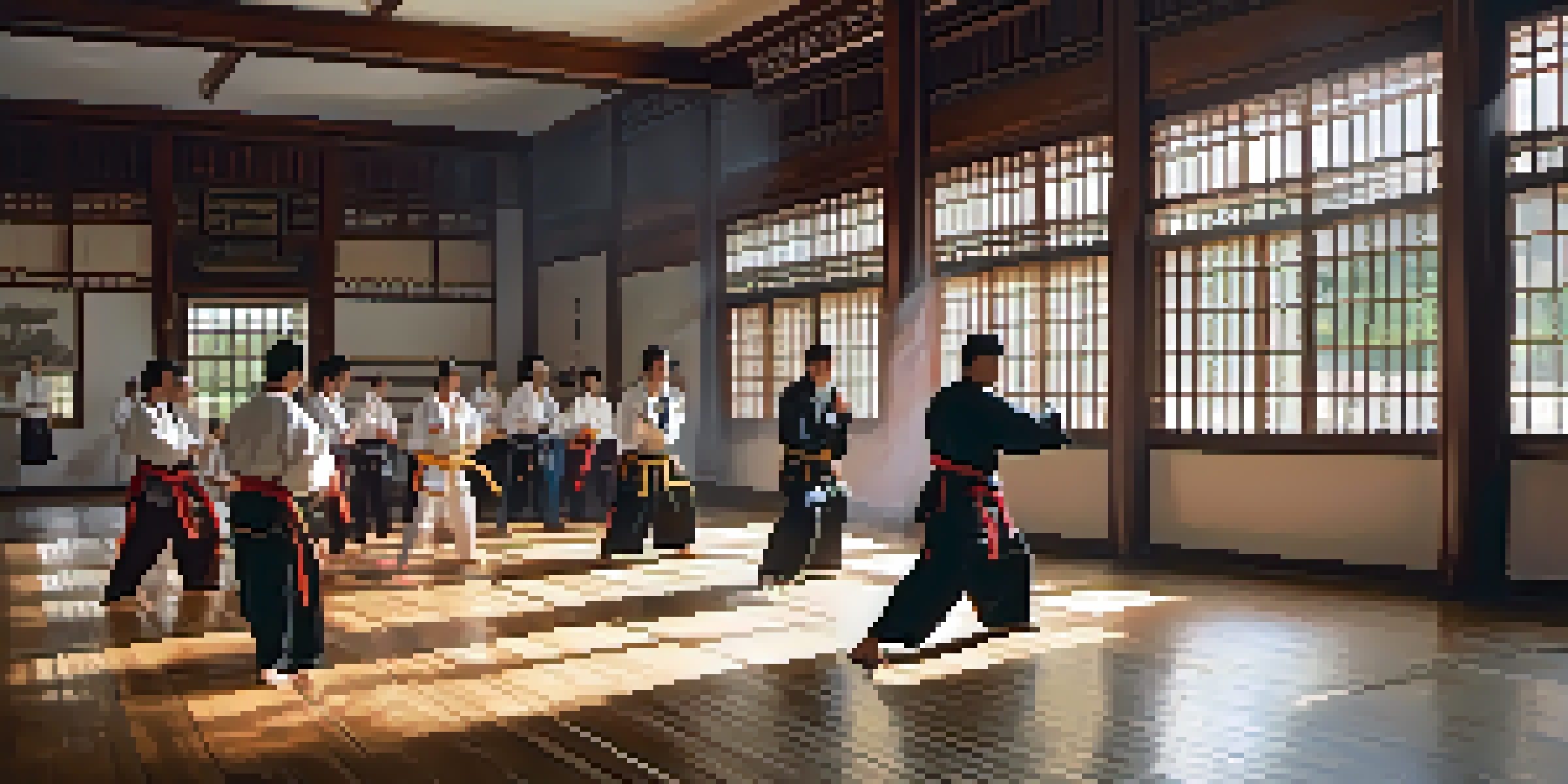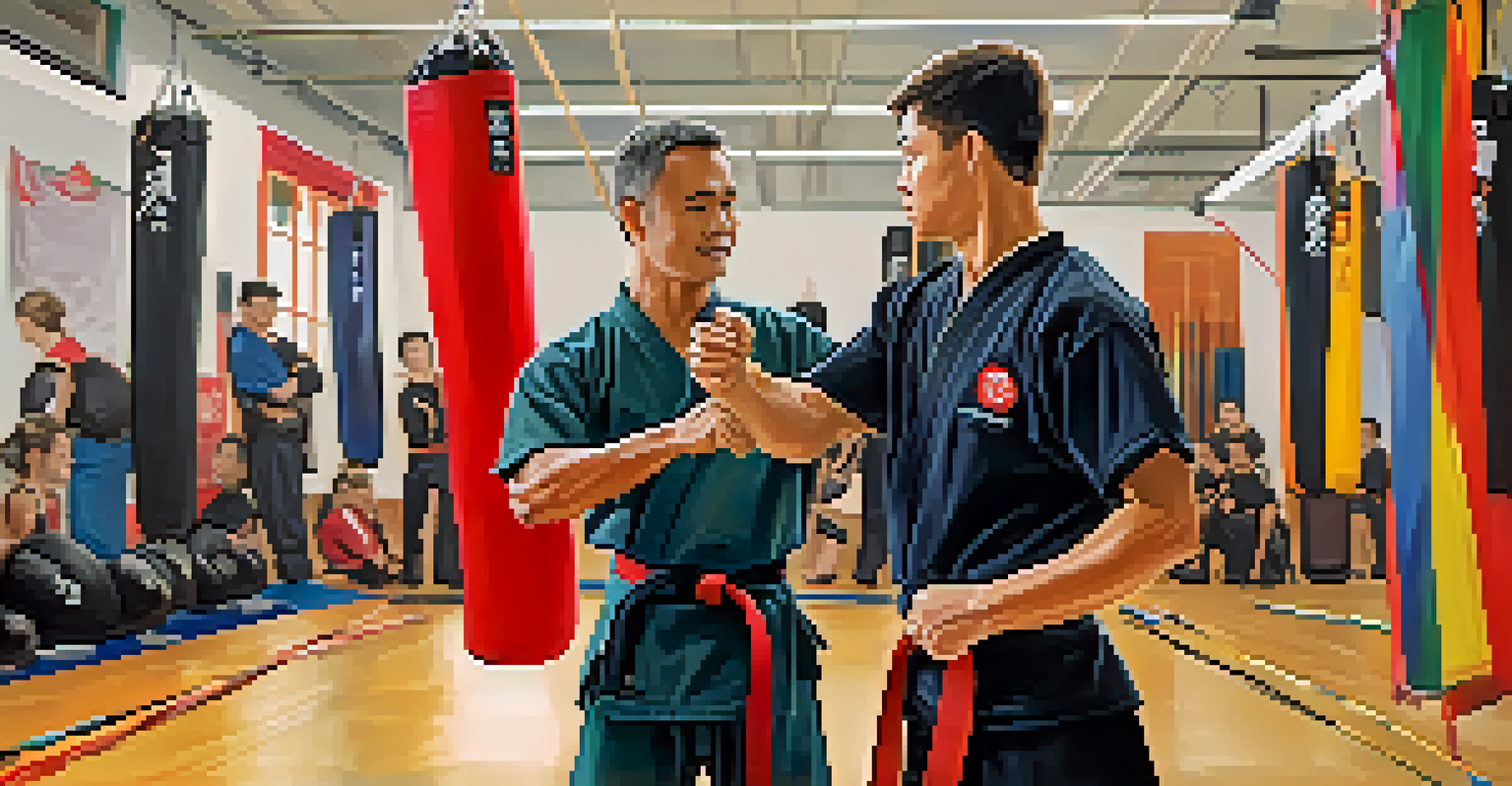Assessing Performance: Feedback Mechanisms in Martial Arts

Understanding Feedback Mechanisms in Martial Arts
Feedback mechanisms are essential in martial arts as they provide practitioners with insights into their performance. These mechanisms can come from instructors, peers, or even self-assessment. By understanding the various forms of feedback, martial artists can enhance their skills and techniques effectively.
Feedback is the breakfast of champions.
For instance, verbal feedback from a coach during practice can highlight specific areas for improvement, such as stance or technique. Non-verbal cues, like body language from peers, can also indicate how well a technique is being executed. These feedback forms help create a learning environment that encourages growth and development.
Ultimately, feedback is not just about critique; it’s a tool for motivation and self-improvement. By recognizing and utilizing different feedback mechanisms, martial artists can effectively navigate their training journey.
The Role of Coaches in Providing Feedback
Coaches play a pivotal role in delivering constructive feedback to their students. They observe techniques closely and provide insights that can lead to significant improvements. This guidance is vital, especially for beginners who may not yet understand their areas of weakness.

For example, a coach might notice that a student’s kick lacks power and suggest specific drills to enhance strength and technique. This targeted feedback allows students to focus on actionable steps that lead to measurable improvements. Furthermore, a good coach balances critique with encouragement, ensuring that students remain motivated.
Value of Diverse Feedback Sources
Feedback in martial arts comes from coaches, peers, and self-assessment, all of which enhance skill development.
Effective coaching feedback fosters a positive learning atmosphere where students feel safe to experiment and make mistakes. This dynamic not only enhances skill development but also builds confidence in martial artists.
Peer Feedback and Its Impact on Training
Peer feedback is another valuable aspect of martial arts training that often goes underappreciated. Fellow practitioners can offer insights and perspectives that coaches might overlook. This collaborative feedback fosters a sense of community and shared learning among students.
We all need people who will give us feedback. That’s how we improve.
For instance, during a sparring session, a partner might point out a student's defensive weaknesses, allowing them to adjust in real-time. This immediate feedback is crucial for rapid skill development, as it encourages quick adaptation and learning. Moreover, receiving feedback from peers can often feel less intimidating than from a coach.
By cultivating a culture of constructive peer feedback, martial arts schools can enhance the overall training experience. Students learn not only from their own experiences but also from observing and assisting each other.
Self-Assessment: An Important Feedback Tool
Self-assessment is a powerful feedback mechanism that allows martial artists to reflect on their performance. By taking the time to evaluate their own techniques and progress, practitioners can identify areas that need improvement. This process encourages a deeper understanding of their skills and learning styles.
For example, after a training session, a martial artist might review their performance in a sparring match and note specific techniques they struggled with. Keeping a training journal can help track improvements over time, making it easier to set goals for future sessions. This reflective practice empowers students to take ownership of their learning.
Role of Timely Feedback
Providing feedback immediately after actions helps martial artists make necessary adjustments and improves learning retention.
Incorporating self-assessment into regular training can lead to greater self-awareness and accountability. As martial artists become more attuned to their abilities, they can set more realistic and achievable goals.
The Importance of Timely Feedback
Timeliness is a key factor in the effectiveness of feedback. Providing feedback immediately after an action allows for clearer connections to be made between the performance and the commentary. This immediacy helps martial artists make necessary adjustments while the experience is still fresh in their minds.
For instance, if a coach corrects a student's form during a drill, the student can immediately apply the advice in real-time. This immediate response enhances learning retention and improves muscle memory. Conversely, delayed feedback may lead to confusion and less effective learning.
By prioritizing timely feedback, martial arts instructors can significantly enhance their students' learning experiences. Practitioners benefit from quick corrections, leading to faster skill acquisition.
Feedback in Competitive Settings
In competitive martial arts, feedback mechanisms take on an even greater significance. Competitors often rely on real-time feedback from coaches during matches to adapt their strategies. This dynamic interaction can be the difference between winning and losing.
For example, a coach might shout tactical advice during a sparring match, helping the athlete adjust their approach against their opponent. The ability to process and implement this feedback quickly can enhance performance under pressure. Additionally, post-match analysis allows competitors to reflect on their performance and identify areas for future improvement.
Creating a Supportive Environment
A feedback-friendly culture encourages open communication and collaboration, fostering growth and camaraderie among practitioners.
Overall, feedback in competitive settings emphasizes the importance of adaptability and growth. Competitors who actively seek and apply feedback often find themselves achieving greater success.
Creating a Feedback-Friendly Environment
Establishing a feedback-friendly environment is crucial for fostering growth in martial arts training. Instructors and students alike should feel comfortable sharing insights and suggestions. This culture of open communication encourages everyone to contribute to the learning process.
To promote this environment, martial arts schools can implement regular feedback sessions where students can share their experiences and challenges. Incorporating group discussions can also facilitate a deeper understanding of techniques and strategies. A supportive atmosphere not only enhances learning but also builds camaraderie among practitioners.

By nurturing a feedback-friendly culture, martial arts schools can create a thriving community where everyone benefits from shared experiences. This ultimately leads to improved performance and greater satisfaction in martial arts training.